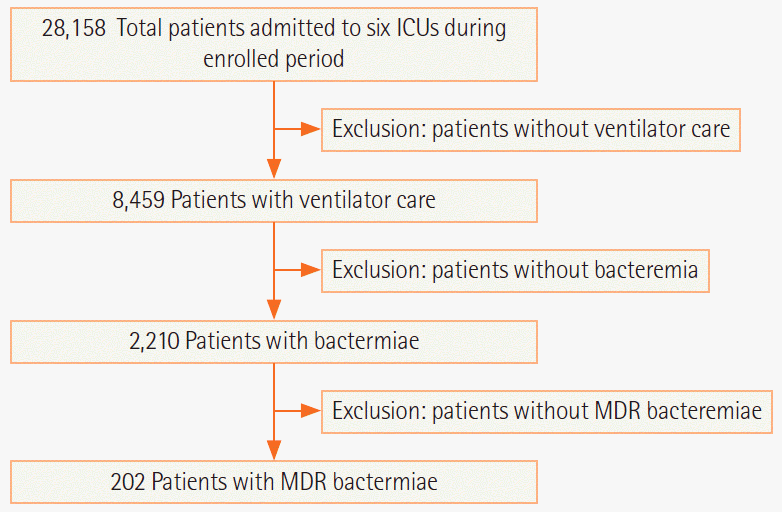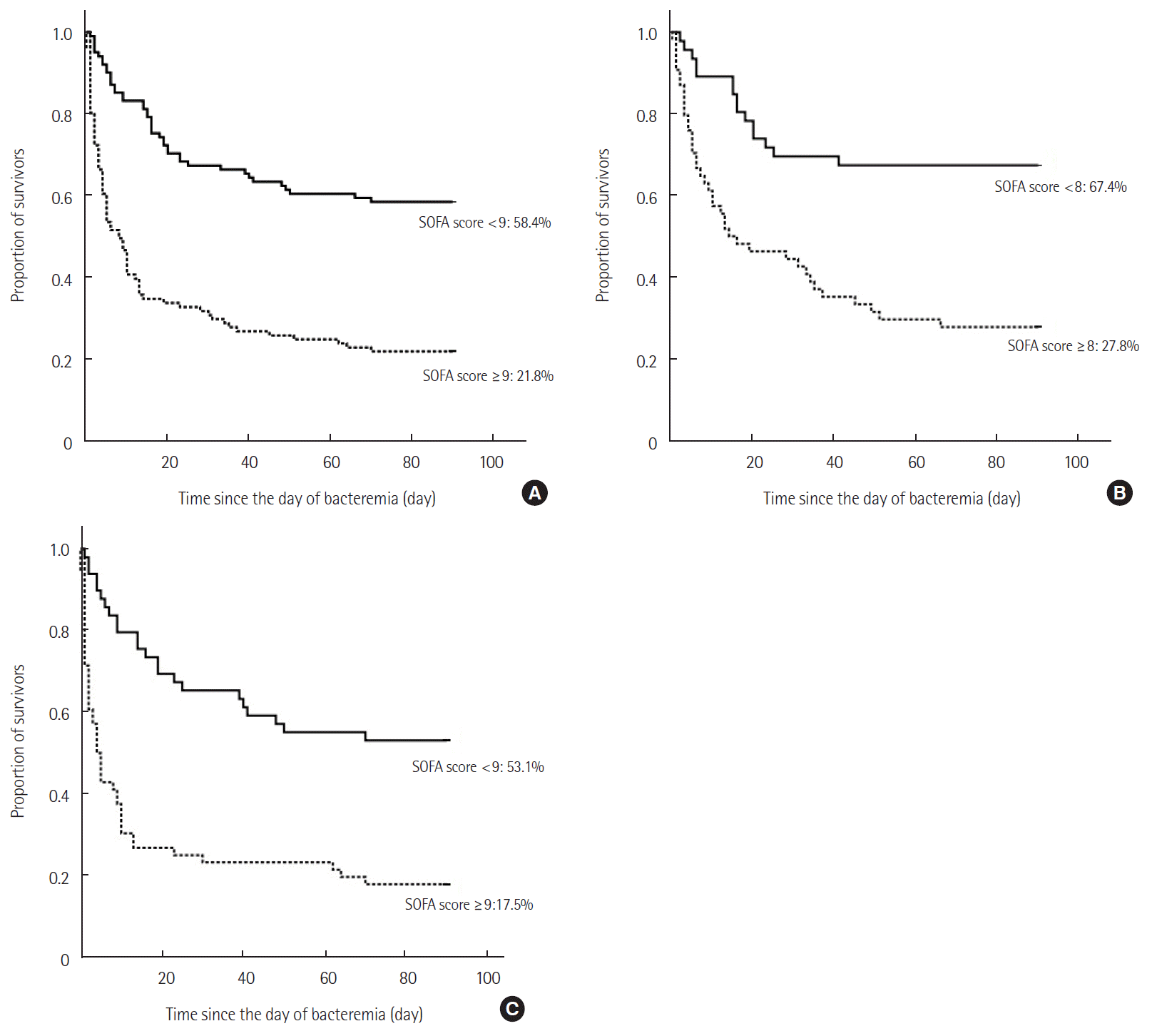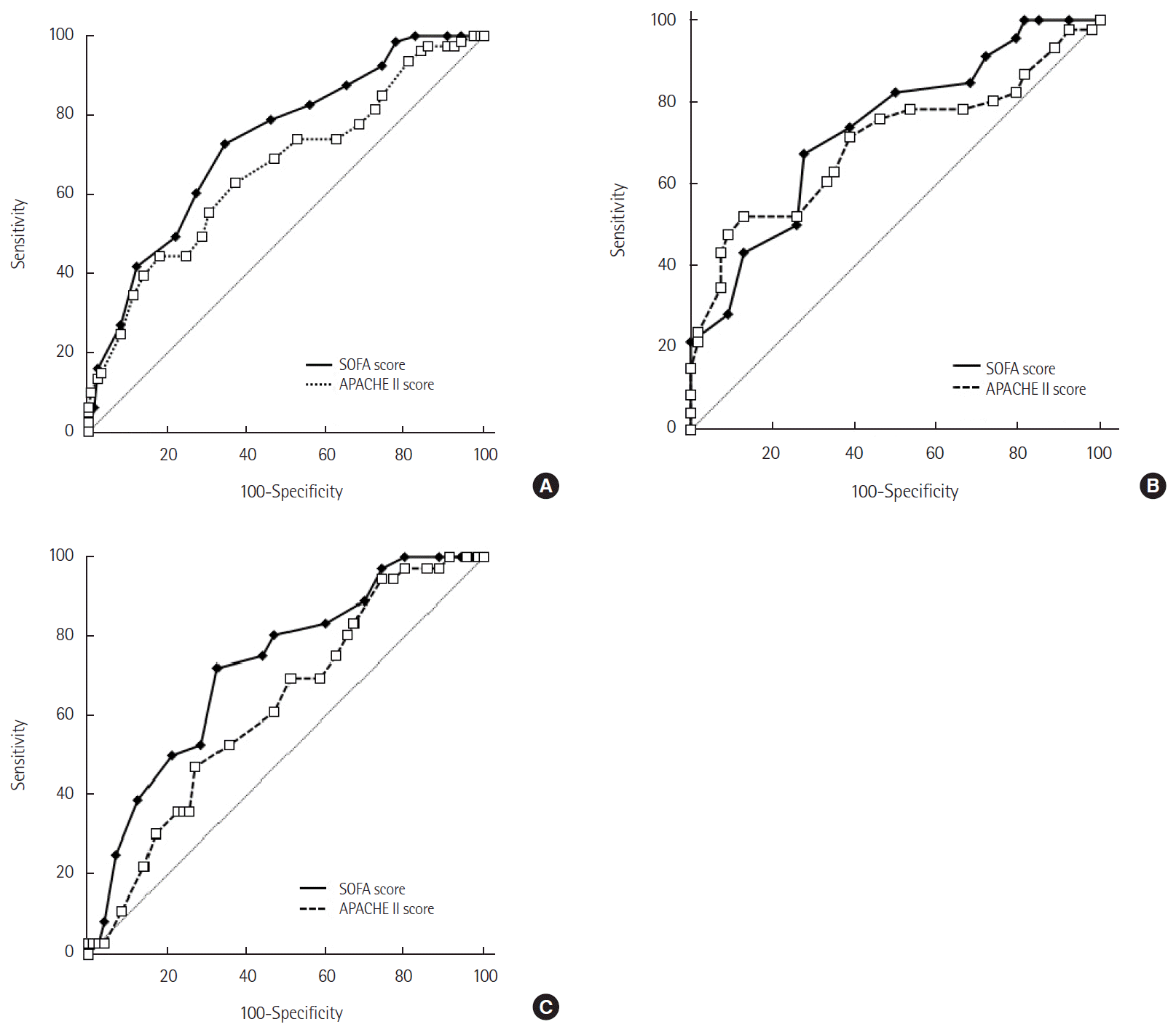INTRODUCTION
MATERIALS AND METHODS
Study Design and Subjects
Data Collection
Statistical Analysis
RESULTS
General Characteristics
 | Figure 1.Flowchart of recruited and enrolled study participants. ICU: intensive care unit; MDR: multidrug-resistant. |
Table 1.
| Characteristics | Total (n=202) |
|---|---|
| Age (yr) | 64 (18–95) |
| Male sex | 122 (60.4) |
| Hospital LOS (day) | 40 (2–431) |
| ICU LOS (day) | 23 (1–430) |
| Duration of MV (day) | 17 (1–430) |
| Comorbidity | |
| Cardiovascular disease | 63 (31.2) |
| Diabetes mellitus | 55 (27.2) |
| Hemato-oncological diseases | 43 (21.3) |
| Cerebrovascular diseases | 31 (15.3) |
| Chronic renal diseases | 27 (13.4) |
| Chronic lung diseases | 15 (7.4) |
| Chronic liver diseases | 13 (6.4) |
| Neuromuscular diseases | 12 (5.9) |
| Biliary diseases | 9 (4.5) |
| Alimentary diseases | 8 (4.0) |
| Main infection source | |
| Pneumonia | 98 (48.5) |
| Vascular catheter-related | 46 (22.8) |
| Intra-abdominal | 25 (12.4) |
| Musculoskeletal and soft tissue | 15 (7.4) |
| Urinary | 9 (4.5) |
| Othera | 9 (4.5) |
| Period from ICU admission to bacteremia (day) | 9 (0–360) |
| APACHE II scoreb | 19 (5–38) |
| SOFA scoreb | 9 (2–20) |
| Microorganism identified | |
| Methicillin-resistant Staphylococcus aureus | 77 (38.1) |
| Vancomycin-resistant Enterococcus faecium | 25 (12.4) |
| Carbapenem-resistant Acinetobacter baumannii | 63 (31.2) |
| ESBL(+) Klebsiella pneumoniae | 25 (12.4) |
| ESBL(+) Escherichia coli | 18 (8.9) |
| Carbapenem-resistant Pseudomonas aeruginosa | 5 (2.5) |
| Requirement for vasopressorsb | 113 (55.9) |
| Requirement for hemodialysisb | 56 (29.2) |
| Requirement for neuromuscular blocking agentsb | 51 (25.2) |
| ARDS on the day of bacteremia | 153 (75.7) |
| ID consultations by ID specialists regarding management of bacteremia | 128 (63.4) |
| Period from day of bacteremia to hospital discharge (day) | 18 (0–373) |
| In-hospital mortality | 115 (56.9) |
| 90-Day mortality after bacteremia | 121 (59.9) |
Values are presented as median (range) or number (%).
LOS: length of stay; ICU: intensive care unit; MV: mechanical ventilation; APACHE: Acute Physiology and Chronic Health Evaluation; SOFA: Sequential Organ Failure Assessment; ESBL: extended-spectrum β-lactamase-producing; ARDS: acute respiratory distress syndrome; ID: infectious diseases.
Predicting Mortality Using SOFA Score
Table 2.
| Category | AUC (95% CI) | Cutoff valuea | Sensitivity (95% CI) | Specificity (95% CI) | Positive likelihood ratio (95% CI) | Negative likelihood ratio (95% CI) | Positive predictive value (95% CI) | Negative predictive value (95% CI) | |
|---|---|---|---|---|---|---|---|---|---|
| Total patients | 0.732 (0.666–0.792) | 9 | 72.8 (61.8–82.1) | 65.3 (56.1–73.7) | 2.1 (1.6–2.8) | 0.4 (0.3–0.6) | 58.4 (51.5–65.0) | 78.2 (71.1–84.0) | |
| Subgroup | |||||||||
| Gram-positive bacteremia | 0.733 (0.636–0.817) | 8 | 67.4 (52.0–80.5) | 72.2 (58.4–83.5) | 2.4 (1.5–3.9) | 0.5 (0.3–0.7) | 67.4 (56.2–76.9) | 72.2 (62.4–80.3) | |
| Gram-negative bacteremia | 0.720 (0.624–0.803) | 9 | 72.2 (54.8–85.8) | 67.1 (54.9–77.9) | 2.2 (1.5–3.3) | 0.4 (0.2–0.7) | 53.1 (43.3–62.6) | 82.5 (73.0–89.1) | |
The data show the cutoff values of Sequential Organ Failure Assessment score for 90-day mortality after the day of bacteremia as determined by ROC curve analyses in total patients and in patients with Gram-positive or Gram-negative bacteremia. Also shown are the sensitivity, specificity, positive likelihood ratio, negative likelihood ratio, positive predictive value, and negative predictive value of these cutoffs for predicting mortality.
AUC: area under the receiver operating characteristic curve; CI: confidence interval.
Table 3.
| Characteristics | Survivor (n=81) | Non-survivor (n=121) | P-value |
|---|---|---|---|
| Comorbiditya | |||
| Cardiovascular disease | 26 (32.1) | 37 (30.6) | 0.877 |
| Diabetes mellitus | 25 (30.9) | 30 (24.8) | 0.420 |
| Hemato-oncological diseases | 11 (13.6) | 32 (26.4) | 0.035 |
| Cerebrovascular diseases | 13 (16.0) | 18 (14.9) | 0.844 |
| Chronic renal diseases | 11 (13.6) | 16 (13.2) | >0.999 |
| Main infection sourcea | |||
| Respiratory | 37 (45.7) | 61 (50.4) | 0.566 |
| Vascular catheter-related | 27 (33.3) | 19 (15.7) | 0.006 |
| Intra-abdominal | 3 (3.7) | 22 (18.2) | 0.002 |
| Musculoskeletal and soft tissue | 7 (8.6) | 8 (6.6) | 0.595 |
| Urinary | 5 (6.2) | 4 (3.3) | 0.489 |
| Microorganism identified | |||
| Methicillin-resistant Staphylococcus aureus | 41 (50.6) | 36 (29.8) | 0.003 |
| Vancomycin-resistant Enterococcus faecium | 5 (6.2) | 20 (16.5) | 0.030 |
| Carbapenem-resistant Acinetobacter baumannii | 22 (27.2) | 41 (33.9) | 0.354 |
| ESBL(+) Klebsiella pneumoniae | 9 (11.1) | 16 (13.2) | 0.828 |
| ESBL(+) Escherichia coli | 7 (8.6) | 11 (9.1) | >0.999 |
| Carbapenem-resistant Pseudomonas aeruginosa | 0 | 5 (4.1) | 0.084 |
| Requirement for vasopressorsb | 30 (37.0) | 83 (68.6) | <0.001 |
| Requirement for hemodialysisb | 13 (16.0) | 46 (38.0) | 0.001 |
| Requirement for neuromuscular blocking agentsb | 15 (18.5) | 36 (29.8) | 0.098 |
| Consultation with an ID specialist regarding management of bacteremia | 61 (75.3) | 67 (55.4) | 0.005 |
| ARDSb | 47 (58.0) | 106 (87.6) | <0.001 |
 | Figure 2.Kaplan-Meier analysis of 90-day survival after the day of bacteremia according to Sequential Organ Failure Assessment (SOFA) score cut-off values in (A) all enrolled patients, (B) Gram-positive patients, and (C) Gram-negative patients. Differences between patients above and below the cut-offs were (A) 39.39% (P<0.001), (B) 16.53% (P<0.001), and (C) 22.69% (P<0.001) by log-rank tests. |
Table 4.
| Factor |
Univariate analysis |
Multivariate analysis |
||
|---|---|---|---|---|
| HR (95% CI) | P-value | HR (95% CI) | P-value | |
| Total patients | ||||
| SOFA score ≥9a | 3.099 (2.123–4.523) | <0.001 | 2.886 (1.946–4.221) | <0.001 |
| No infectious disease consultation | 2.193 (1.528–3.146) | <0.001 | 2.261 (1.534–3.331) | <0.001 |
| Intra-abdominal infections as source of infection | 2.614 (1.637–4.172) | <0.001 | 2.023 (1.252–3.268) | 0.004 |
| Requirement for NMBAsa | 1.629 (1.102–2.409) | 0.014 | ||
| Hemato-oncologic diseases as comorbidities | 1.714 (1.142–2.572) | 0.009 | ||
| Gram-positive bacteremia | ||||
| SOFA score ≥8a | 3.206 (1.763–5.831) | <0.001 | 2.458 (1.312–4.603) | 0.005 |
| Age ≥65 years | 2.251 (1.311–3.866) | 0.003 | 1.942 (1.116–3.379) | 0.019 |
| Hemato-oncologic malignancies as comorbidities | 4.032 (2.059–7.894) | <0.001 | ||
| Requirement for NMBAsa | 1.875 (1.053–3.341) | 0.033 | ||
| Intra-abdominal infections as source of infection | 5.473 (2.390–12.535) | <0.001 | ||
| No infectious disease consultation | 1.767 (1.025–3.046) | 0.040 | ||
| Gram-negative bacteremia | ||||
| SOFA score ≥9a | 3.129 (1.886–5.189) | <0.001 | 2.987 (1.786–4.995) | <0.001 |
| No infectious disease consultation | 2.709 (1.677–4.376) | <0.001 | 2.671 (1.641–4.348) | <0.001 |
| Intra-abdominal infections as source of infection | 1.785 (1.005–3.171) | 0.048 | ||
Statistical significance was determined by univariate and multivariate Cox proportional hazards models. Mortality was defined as mortality 90 days after the day of blood culture.
HR: hazard ratio; CI: confidence interval; SOFA: Sequential Organ Failure Assessment; NMBA: neuromuscular blocking agent.
Comparison of SOFA Score with APACHE II Score on the Day of Bacteremia
 | Figure 3.Receiver operating characteristic (ROC) curves for Sequential Organ Failure Assessment (SOFA) and Acute Physiology and Chronic Health Evaluation (APACHE) II scores for predicting 90-day mortality after the day of bacteremia in (A) all enrolled patients, (B) Gram-positive patients, and (C) Gram-negative patients. (A) In all patients, the area under the ROC curves for the SOFA and APACHE II scores were 0.732 (95% confidence interval [CI], 0.666–0.792; P<0.001) and 0.662 (95% CI, 0.593–0.727; P<0.001), respectively, with no difference between the two (P=0.059). (B) In patients with Gram-positive bacteremia, the AUCs for the SOFA and APACHE II scores were 0.733 (95% CI, 0.636–0.817; P<0.001) and 0.701 (95% CI, 0.601–0.788; P<0.001), respectively, with no difference between the two (P=0.572). (C) In patients with Gram-negative bacteremia, the AUCs for the SOFA and APACHE II scores were 0.720 (95% CI, 0.624–0.803; P<0.001) and 0.622 (95% CI, 0.523–0.714; P<0.001), respectively. The AUC for SOFA score was significantly higher than the AUC for APACHE II score (P=0.037). |




 PDF
PDF Citation
Citation Print
Print



 XML Download
XML Download